As it relates to color in the garden, one of my goals is to create year-round interest. Looking through my pictures, the year starts with whites and yellows; the middle months have a full range of of bright colors; and the year ends with the deep colors of berries. Here is a brief overview of these colors with one picture for each month of the year.
This post was inspired by the "Garden Bloggers' Design Workshop - Colors in the Garden" at one of my favorite gardening blogs, Gardening Gone Wild: http://www.gardeninggonewild.com/?p=698 January in northern New Jersey (zone 6b) is a hard month to find any color in the garden. Fortunately, whenever the weather warms up into the forties, the forsythia start to show off some of their blooms. Of course, when it gets cold again, they hide themselves away until it warms up in earnest. This is the time when I start to cut the branches off and bring them indoors to force--my favorite thing to do with forsythia.
January in northern New Jersey (zone 6b) is a hard month to find any color in the garden. Fortunately, whenever the weather warms up into the forties, the forsythia start to show off some of their blooms. Of course, when it gets cold again, they hide themselves away until it warms up in earnest. This is the time when I start to cut the branches off and bring them indoors to force--my favorite thing to do with forsythia.
 February is the month for snowdrops. I have snowdrops in the Cutting Garden and, last fall, planted more in the Walled Garden. These small flowers are so cute and the first real sign that spring is coming. Given their size, you really can't plant too many of them--think hundreds. Since I like to plant a lot, I buy my snowdrops wholesale from Van Engelen. Once they come up, I cut small bunches for vases. Pests do not eat these bulbs.
February is the month for snowdrops. I have snowdrops in the Cutting Garden and, last fall, planted more in the Walled Garden. These small flowers are so cute and the first real sign that spring is coming. Given their size, you really can't plant too many of them--think hundreds. Since I like to plant a lot, I buy my snowdrops wholesale from Van Engelen. Once they come up, I cut small bunches for vases. Pests do not eat these bulbs. The March bulb show begins with winter aconite. It is another small bulb that I planted under Prunus 'Forest Pansy' in my front border. It took me a couple of years for me to get these established. I was most successful with bulbs from Old House Gardens. I think the difference was that these bulbs dry out very easily and Old House Gardens coats the bulbs in a horticultural wax to prevent this. If you know someone with an established clump, it's best to beg a few in the green and replant them immediately in your garden. Pests do not eat these bulbs.
The March bulb show begins with winter aconite. It is another small bulb that I planted under Prunus 'Forest Pansy' in my front border. It took me a couple of years for me to get these established. I was most successful with bulbs from Old House Gardens. I think the difference was that these bulbs dry out very easily and Old House Gardens coats the bulbs in a horticultural wax to prevent this. If you know someone with an established clump, it's best to beg a few in the green and replant them immediately in your garden. Pests do not eat these bulbs. April, of course, is the month for daffodils. I plant hundreds of daffodils all over the garden. I plant all sizes and colors, but am particularly fond of the white daffodils. The earliest actually start to bloom at the end of March and they last through April into May. Pictured here is an old heirloom Thalia.
April, of course, is the month for daffodils. I plant hundreds of daffodils all over the garden. I plant all sizes and colors, but am particularly fond of the white daffodils. The earliest actually start to bloom at the end of March and they last through April into May. Pictured here is an old heirloom Thalia. May is one of my favorite months in the garden as tulips explode everywhere. Last year, my combination was inspired by the Granny's Garden collection from Old House Gardens. I planted a mix of the following tulips, most of which are older varieties: Cum Laude, Glowing Pink, Kingsblood, Maureen, Queen of the Night, Dillenborg, Mrs. John Scheepers, Colour Cardinal, Princess Irene, and Ballerina.
May is one of my favorite months in the garden as tulips explode everywhere. Last year, my combination was inspired by the Granny's Garden collection from Old House Gardens. I planted a mix of the following tulips, most of which are older varieties: Cum Laude, Glowing Pink, Kingsblood, Maureen, Queen of the Night, Dillenborg, Mrs. John Scheepers, Colour Cardinal, Princess Irene, and Ballerina.
 July is when the plants from and reminescent of the American prairie take over. Purple coneflower, the many rudbeckias, joe pye weed, heleniums, helianthus, phlox, milkweed, monarda, erygium, echinops, and shasta daisies all begin their bloom. These plants, despite the heat and humidity of summer, keep going and going while attracting many birds, hummers, and butterflies to the garden. By mixing these with grasses, you have color, movement, and beauty that will carry you well into September.
July is when the plants from and reminescent of the American prairie take over. Purple coneflower, the many rudbeckias, joe pye weed, heleniums, helianthus, phlox, milkweed, monarda, erygium, echinops, and shasta daisies all begin their bloom. These plants, despite the heat and humidity of summer, keep going and going while attracting many birds, hummers, and butterflies to the garden. By mixing these with grasses, you have color, movement, and beauty that will carry you well into September. One of my daughters is in love with hibiscus and has been reminding me I haven't put a picture of her hibiscus on my blog yet. In August, the huge tropical looking flowers garner lots of attention. The flowers are great floated in a vase and keep coming over a long period of time. Also, the seed pods of the hibiscus are quite beautiful afterward.
One of my daughters is in love with hibiscus and has been reminding me I haven't put a picture of her hibiscus on my blog yet. In August, the huge tropical looking flowers garner lots of attention. The flowers are great floated in a vase and keep coming over a long period of time. Also, the seed pods of the hibiscus are quite beautiful afterward. September is part of summer in my book. The garden is still in full swing with no sign of winding down. By the end of the month, however, the Japanese anemone 'Queen Charlotte' is beginning to bloom, signaling the very beginning of fall.
September is part of summer in my book. The garden is still in full swing with no sign of winding down. By the end of the month, however, the Japanese anemone 'Queen Charlotte' is beginning to bloom, signaling the very beginning of fall. 
 The butterfly weed pictured here was a welcome volunteer from a clump of Mexican milkweed I planted in 2006. I did not expect it to reseed for me given that its grown mainly in zone 8 and warmer. But the seedling did come and were enjoyed by many monarch catepillars. The plants came into bloom very late in the season. They, however, made it through many light frosts and only died well into November when we had a hard frost.
The butterfly weed pictured here was a welcome volunteer from a clump of Mexican milkweed I planted in 2006. I did not expect it to reseed for me given that its grown mainly in zone 8 and warmer. But the seedling did come and were enjoyed by many monarch catepillars. The plants came into bloom very late in the season. They, however, made it through many light frosts and only died well into November when we had a hard frost.










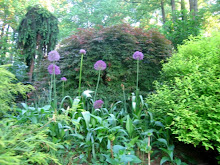
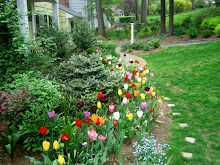
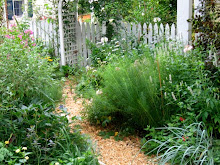
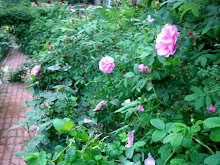

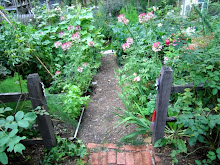

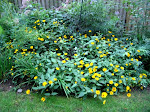





17 comments:
I love your 12-months-of-color approach! And that's a great tip about the Eranthis; many thanks for that. I too have had trouble getting them established.
I really enjoyed your retrospective on color in the garden. I liked how you related each month to what bloomed during that month. Thanks.~~Dee
I love seeing your year of flowers in the garden. Tulips in May! Tulips at any time of year. How envious I am!
We do manage to grow some of the same plants but the times they bloom are quite different.
At least we have one thing in common. January is not a good month for flowers here in Texas either, except for the bedded out pansies and snapdragons.
My gardens seem to follow pretty much the same color patterns as your lovely garden. I have seen Snowdrops & Winter aconite blooming together in gardens, but, like yours, mine can't get together & the aconites always bloom later.
Oh noo...!
Its make you yearn more to spring and summer.
Okey.. I think I must say that you year in your garden seams to have allot of color and beauty ;)
Ken
Mr. McGregor's Daughter--
Snowdrops and Winter Aconite together? I'd love to see that.
-Heirloom Gardener
Thanks for the month-by-month tour of your lovely garden. You've done a great job and your garden is rewarding you with its amazing array of color and texture.
I like to hear the bloom times of your plants, same succession as here in southeast TN but about 4 weeks later. The hybrid musk roses are my favorites, Belinda is quite the beauty. Thanks for a lovely post.
Frances at Faire Garden
This is my first visit to your blog - I think you've got a very nice blog indeed. I really enjoyed reading your comments about the year in your garden, and the beautiful pictures too. - Thank you for sharing.
(We've got quite a lot of the plants you mentioned in our garden, even though we're far, far away.)
Katarina (Sweden)
HI!
About our waterlilly,
I dont find any pictures from the last summer a´m afraid.
We made like a well from a oilbrill,
we digg it about 3/4 down and built abow the ground a wall of stones around it.
In the well we put a basket for underwatherplants and plant the lilly there.(it´s 1,2 cm deep)
I think we live in a zon cooler than you, but our lilly has survived in it for five years., and we tont take it in for the winter.
I promise you that I shall put in a contribution about our Waterlilly-gardenroom, and later in the summer you mayby even get to see the lilly;)
Best regards Ken
Hi - I found your blogspot on Kate's Smudges - some great photos and it looks like the climate must be very similar to Brittany (N.France) where I'm based - I've been busy putting photos of Helebores on my blog as they really are beautiful at this time of year and wonderered if you had any growing yourself... if not definately worth trying!
Will visit again soon - Miranda
Hi there!!!
This is my first visit to your blog - And It´s lovely!!!!!
Your 12 mounth cavalcad is fantastic!
Linda
Miranda,
I planted helebores three years ago but they have not yet bloomed this year. Seeing pictures of your helebores makes me want to plant more. You have a great blog that I just added to my list.
-Heirloom Gardener
Linda,
Thank you for visiting and thank you for the compliment.
-Heirloom Gardener
If this isn't inspiration for color all year I don't know what is. I have not had good luck with winter aconite though. They tend to bloom one year and then disappear. Hmmmmm
Your photos are absolutely gorgeous--thanks for sharing!! I forgot how much I love fall-blooming anemone, for example. :)
I came home from work early because I caught a bug from our grandson. It hit me later than my husband. I am enjoying exploring your blog.
We enjoy a lot of the same flowers here in my zone 5b, Nebraska.
Post a Comment